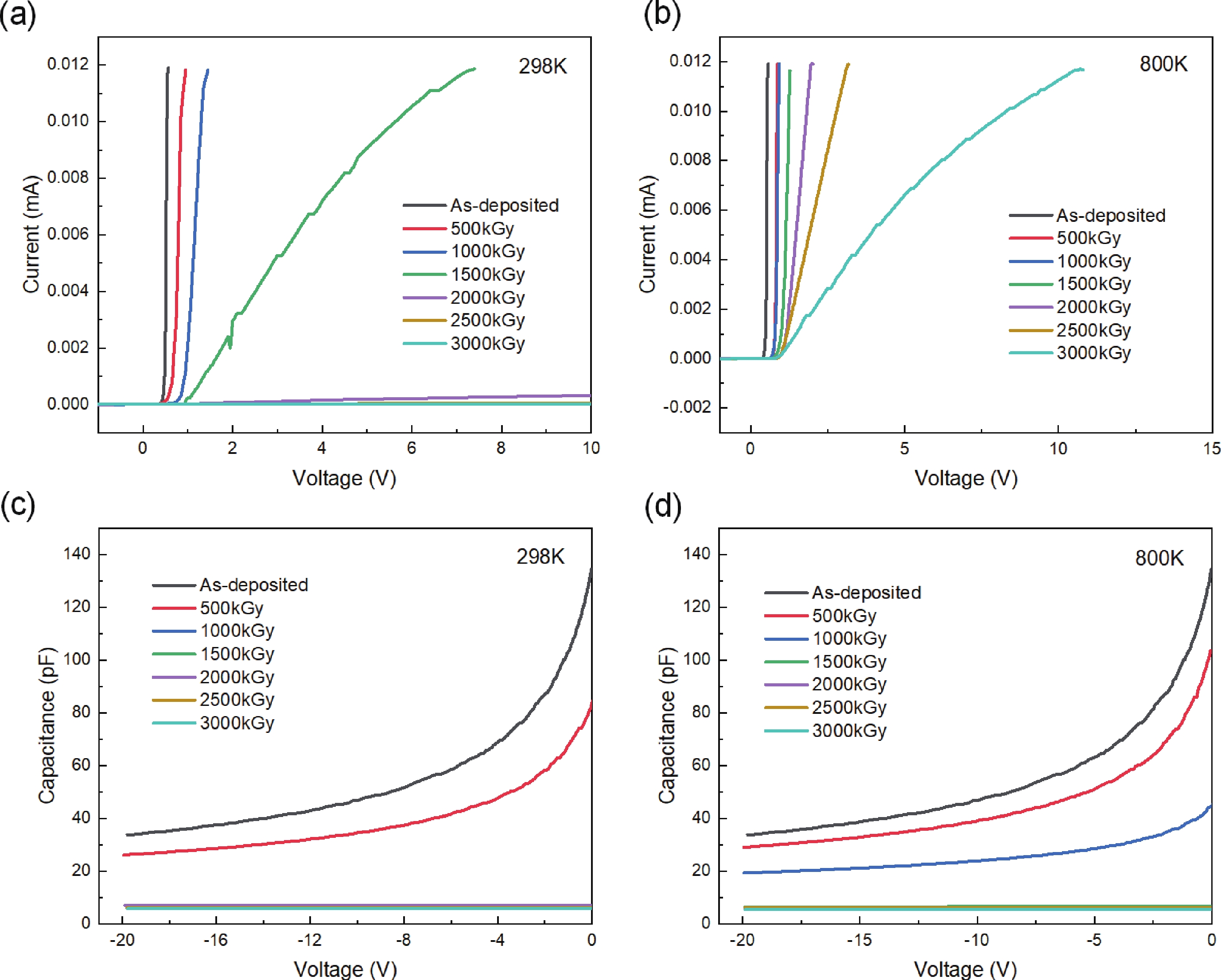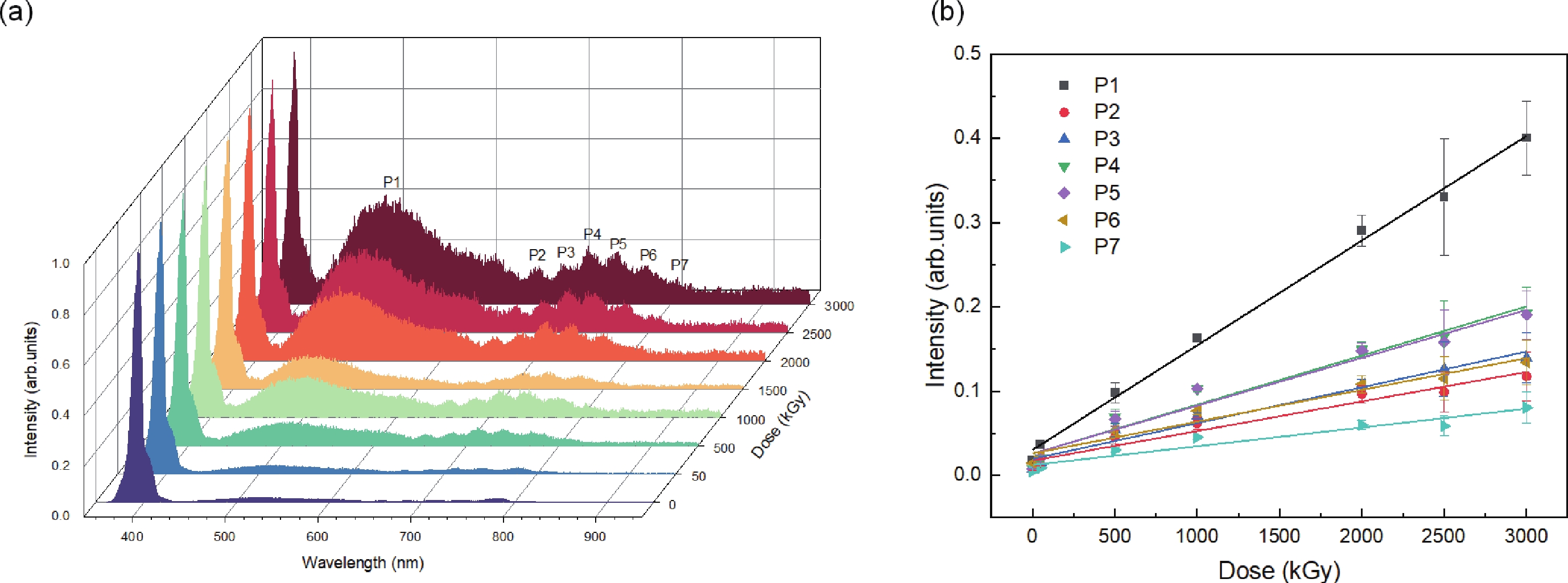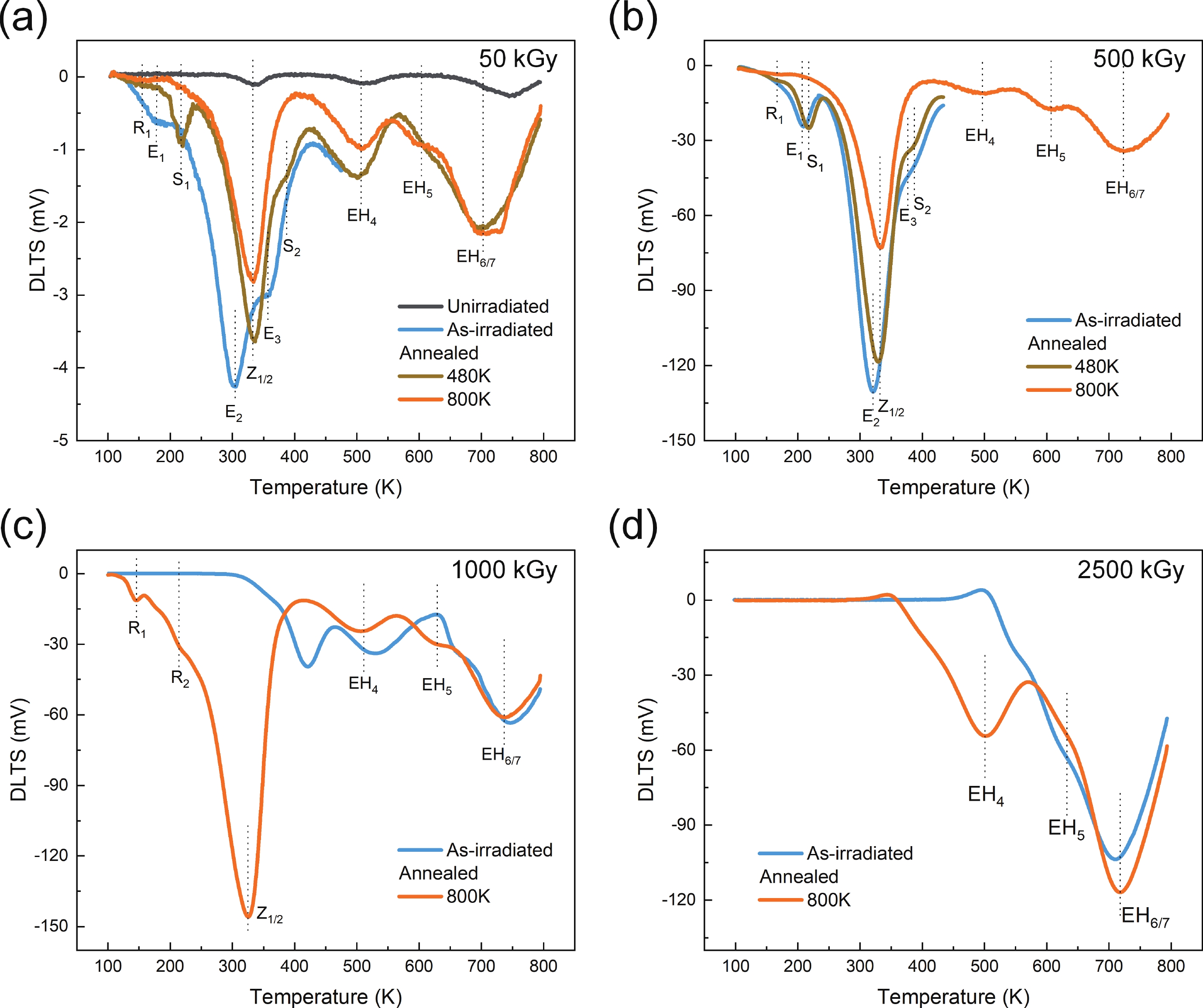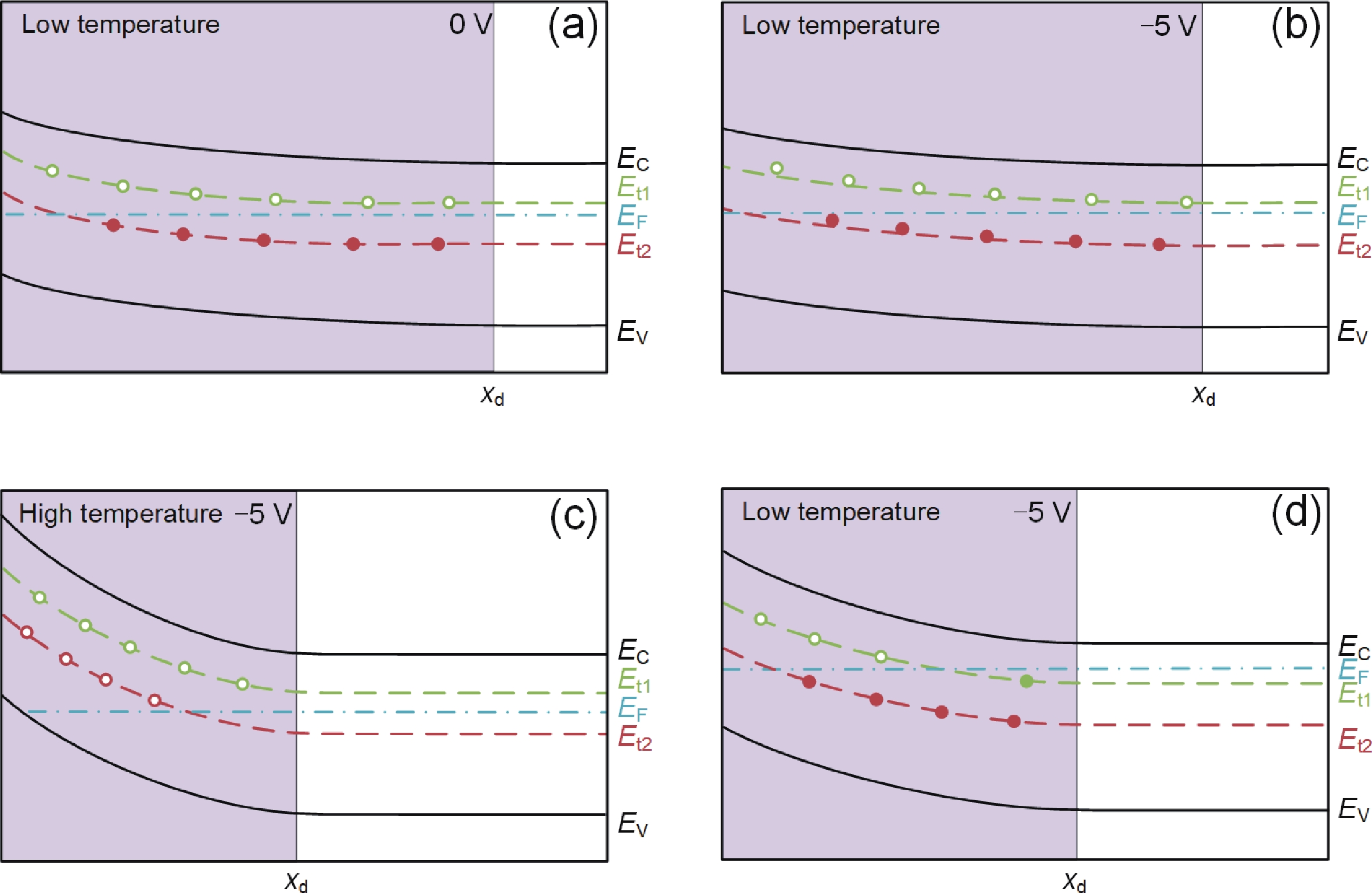| Citation: |
Huifan Xiong, Xuesong Lu, Xu Gao, Yuchao Yan, Shuai Liu, Lihui Song, Deren Yang, Xiaodong Pi. Defects evolution in n-type 4H-SiC induced by electron irradiation and annealing[J]. Journal of Semiconductors, 2024, 45(7): 072502. doi: 10.1088/1674-4926/23090024
****
H F Xiong, X S Lu, X Gao, Y C Yan, S Liu, L H Song, D R Yang, and X D Pi, Defects evolution in n-type 4H-SiC induced by electron irradiation and annealing[J]. J. Semicond., 2024, 45(7), 072502 doi: 10.1088/1674-4926/23090024
|
Defects evolution in n-type 4H-SiC induced by electron irradiation and annealing
DOI: 10.1088/1674-4926/23090024
More Information
-
Abstract
Radiation damage produced in 4H-SiC by electrons of different doses is presented by using multiple characterization techniques. Raman spectra results indicate that SiC crystal structures are essentially impervious to 10 MeV electron irradiation with doses up to 3000 kGy. However, irradiation indeed leads to the generation of various defects, which are evaluated through photoluminescence (PL) and deep level transient spectroscopy (DLTS). The PL spectra feature a prominent broad band centered at 500 nm, accompanied by several smaller peaks ranging from 660 to 808 nm. The intensity of each PL peak demonstrates a linear correlation with the irradiation dose, indicating a proportional increase in defect concentration during irradiation. The DLTS spectra reveal several thermally unstable and stable defects that exhibit similarities at low irradiation doses. Notably, after irradiating at the higher dose of 1000 kGy, a new stable defect labeled as R2 (Ec − 0.51 eV) appeared after annealing at 800 K. Furthermore, the impact of irradiation-induced defects on SiC junction barrier Schottky diodes is discussed. It is observed that high-dose electron irradiation converts SiC n-epilayers to semi-insulating layers. However, subjecting the samples to a temperature of only 800 K results in a significant reduction in resistance due to the annealing out of unstable defects. -
References
[1] Chen X F, Yang X L, Xie X J, et al. Research progress of large size SiC single crystal materials and devices. Light Sci Appl, 2023, 12, 28 doi: 10.1038/s41377-022-01037-7[2] Lohrmann A, Iwamoto N, Bodrog Z, et al. Single-photon emitting diode in silicon carbide. Nat Commun, 2015, 6, 7783 doi: 10.1038/ncomms8783[3] Liu L Y, Liu A, Bai S, et al. Radiation resistance of silicon carbide schottky diode detectors in D-T fusion neutron detection. Sci Rep, 2017, 7, 13376 doi: 10.1038/s41598-017-13715-3[4] Lebedev A A, Kozlovski V V, Davydovskaya K S, et al. Radiation hardness of silicon carbide upon high-temperature electron and proton irradiation. Materials, 2021, 14, 4976 doi: 10.3390/ma14174976[5] Khani M, Griepentrog G, Sokolov A, et al. Radiation hardness of Si- and SiC-power-MOSFETs in particle accelerator environments. PCIM Eur 2022; Int Exhib Conf Power Electron Intell Motion Renew Energy Energy Manag, 2022, 1 doi: 10.30420/565822163[6] Emtsev V V, Ivanov A M, Kozlovski V V, et al. Similarities and distinctions of defect production by fast electron and proton irradiation: Moderately doped silicon and silicon carbide of n-type. Semiconductors, 2012, 46, 456 doi: 10.1134/S1063782612040069[7] Lin Z, Yimen Z, Yuming Z, et al. Neutron radiation effect on 4H-SiC MESFETs and SBDs. J Semicond, 2010, 31, 114006 doi: 10.1088/1674-4926/31/11/114006[8] Dong P, Qin Y Z, Yu X G, et al. Electron radiation effects on the 4H-SiC PiN diodes characteristics: An insight from point defects to electrical degradation. IEEE Access, 2019, 7, 170385 doi: 10.1109/ACCESS.2019.2955385[9] Vobecký J, Hazdra P, Popelka S, et al. Impact of electron irradiation on the on-state characteristics of a 4H–SiC JBS diode. IEEE Trans Electron Devices, 2015, 62, 1964 doi: 10.1109/TED.2015.2421503[10] Paradzah A T, Omotoso E, Legodi M J, et al. Electrical characterization of high energy electron irradiated Ni/4H-SiC Schottky barrier diodes. J Electron Mater, 2016, 45, 4177 doi: 10.1007/s11664-016-4609-z[11] Capan I, Brodar T, Pastuović Ž, et al. Double negatively charged carbon vacancy at the h- and k-sites in 4H-SiC: Combined Laplace-DLTS and DFT study. J Appl Phys, 2018, 123, 161597 doi: 10.1063/1.5011124[12] Son N T, Trinh X T, Løvlie L S, et al. Negative-U system of carbon vacancy in 4H-SiC. Phys Rev Lett, 2012, 109, 187603 doi: 10.1103/PhysRevLett.109.187603[13] Kimoto T, Niwa H, Okuda T, et al. Carrier lifetime and breakdown phenomena in SiC power device material. J Phys D Appl Phys, 2018, 51, 363001 doi: 10.1088/1361-6463/aad26a[14] Storasta L, Tsuchida H. Reduction of traps and improvement of carrier lifetime in 4H-SiC epilayers by ion implantation. Appl Phys Lett, 2007, 90, 062116 doi: 10.1063/1.2472530[15] Nagy R, Niethammer M, Widmann M, et al. High-fidelity spin and optical control of single silicon-vacancy centres in silicon carbide. Nat Commun, 2019, 10, 1954 doi: 10.1038/s41467-019-09873-9[16] Wolfowicz G, Anderson C P, Yeats A L, et al. Optical charge state control of spin defects in 4H-SiC. Nat Commun, 2017, 8, 1876 doi: 10.1038/s41467-017-01993-4[17] Tarasenko S A, Poshakinskiy A V, Simin D, et al. Spin and optical properties of silicon vacancies in silicon carbide−A review. Phys Status Solidi B, 2018, 255, 1700258 doi: 10.1002/pssb.201700258[18] Magnusson B, Son N T, Csóré A, et al. Excitation properties of the divacancy in 4H-SiC. Phys Rev B, 2018, 98, 195202 doi: 10.1103/PhysRevB.98.195202[19] Son N T, Shafizadeh D, Ohshima T, et al. Modified divacancies in 4H-SiC. J Appl Phys, 2022, 132, 025703 doi: 10.1063/5.0099017[20] Seo H, Falk A L, Klimov P V, et al. Quantum decoherence dynamics of divacancy spins in silicon carbide. Nat Commun, 2016, 7, 12935 doi: 10.1038/ncomms12935[21] Son N T, Stenberg P, Jokubavicius V, et al. Energy levels and charge state control of the carbon antisite-vacancy defect in 4H-SiC. Appl Phys Lett, 2019, 114, 212105 doi: 10.1063/1.5098070[22] Polking M J, Dibos A M, de Leon N P, et al. Improving defect-based quantum emitters in silicon carbide via inorganic passivation. Adv Mater, 2018, 30, 1704543 doi: 10.1002/adma.201704543[23] Coutinho J. Theory of the thermal stability of silicon vacancies and interstitials in 4H-SiC. Crystals, 2021, 11, 167 doi: 10.3390/cryst11020167[24] Karsthof R, Bathen M E, Galeckas A, et al. Conversion pathways of primary defects by annealing in proton-irradiated n-type 4H-SiC. arXiv: 2007.03985, 2020 doi: 10.1103/PhysRevB.102.184111[25] Son N T, Carlsson P, ul Hassan J, et al. Divacancy in 4H-SiC. Phys Rev Lett, 2006, 96, 055501 doi: 10.1103/PhysRevLett.96.055501[26] Kuate D R, Zhang X Y, Bracher D O, et al. Energetics and kinetics of vacancy defects in 4H-SiC. Phys Rev B, 2018, 98, 104103 doi: 10.1103/PhysRevB.98.104103[27] Nakane H, Kato M, Ohkouchi Y, et al. Deep levels related to the carbon antisite–vacancy pair in 4H-SiC. J Appl Phys, 2021, 130, 065703 doi: 10.1063/5.0059953[28] Kaneko H, Kimoto T. Formation of a semi-insulating layer in n-type 4H-SiC by electron irradiation. Appl Phys Lett, 2011, 98(26), 262106 doi: 10.1063/1.3604795[29] Lebedev A A, Kozlovski V V, Davydovskaya K S, et al. Features of the carrier concentration determination during irradiation of wide-gap semiconductors: The case study of silicon carbide. Materials, 2022, 15, 8637 doi: 10.3390/ma15238637[30] Ahoujja M, Crocket H C, Scott M B, et al. Photoluminescence characterization of defects introduced in 4H-SiC during high energy proton irradiation and their annealing behavior. MRS Online Proc Libr, 2004, 815, 147 doi: 10.1557/PROC-815-J5.21[31] Castelletto S, Johnson B C, Ivády V, et al. A silicon carbide room-temperature single-photon source. Nat Mater, 2014, 13, 151 doi: 10.1038/nmat3806[32] Steeds J. Photoluminescence study of the carbon antisite-vacancy pair in 4H- and 6H-SiC. Phys Rev B Condens Matter, 2009, 80, 245202 doi: 10.1103/PhysRevB.80.245202[33] Dietz J R, Hu E L. Optical and strain stabilization of point defects in silicon carbide. Appl Phys Lett, 2022, 120 , 184001 doi: 10.1063/5.0087805[34] Rühl M, Ott C, Götzinger S, et al. Controlled generation of intrinsic near-infrared color centers in 4H-SiC via proton irradiation and annealing. Appl Phys Lett, 2018, 113, 122102 doi: 10.1063/1.5045859[35] Lebedev A A, Ber B Y, Seredova N V, et al. Radiation-stimulated photoluminescence in electron irradiated 4H-SiC. J Phys D Appl Phys, 2015, 48, 485106 doi: 10.1088/0022-3727/48/48/485106[36] Lebedev A A. Deep level centers in silicon carbide: A review. Semiconductors, 1999, 33, 107 doi: 10.1134/1.1187657[37] Antonio C, Anna C, Lorenzo R, et al. Low temperature annealing of electron irradiation induced defects in 4H-SiC. Appl Phys Lett, 2004, 85, 3780 doi: 10.1063/1.1810627[38] Hazdra P, Vobecký J. Radiation defects created in n-type 4H-SiC by electron irradiation in the energy range of 1–10 MeV. Phys Status Solidi A, 2019, 216, 1900312 doi: 10.1002/pssa.201900312[39] Alfieri G, Monakhov E V, Svensson B G, et al. Annealing behavior between room temperature and 2000 °C of deep level defects in electron-irradiated n-type 4H silicon carbide. J Appl Phys, 2005, 98, 043518 doi: 10.1063/1.2009816[40] David M L, Alfieri G, Monakhov E M, et al. Electrically active defects in irradiated 4H-SiC. J Appl Phys, 2004, 95, 4728 doi: 10.1063/1.1689731[41] Alfieri G, Monakhov E V, Svensson B G, et al. Defect energy levels in hydrogen-implanted and electron-irradiated n-type 4H silicon carbide. J Appl Phys, 2005, 98, 113524 doi: 10.1063/1.2139831[42] Hemmingsson C, Son N T, Kordina O, et al. Deep level defects in electron-irradiated 4H-SiC epitaxial layers. J Appl Phys, 1997, 81, 6155 doi: 10.1063/1.364397[43] Hazdra P, Záhlava V, Vobecky J, et al. Radiation defects produced in 4H-SiC epilayers by proton and alpha-particle irradiation. Materials Science Forum, 2013, 2266, 661 doi: 10.4028/www.scientific.net/MSF.740-742.661[44] Iwata H P, Lindefelt U, Öberg S, et al. Effective masses of two-dimensional electron gases around cubic inclusions in hexagonal silicon carbide. Phys Rev B, 2003, 68, 245309 doi: 10.1103/PhysRevB.68.245309[45] Szász K, Ivády V, Abrikosov I A, et al. Spin and photophysics of carbon-antisite vacancy defect in 4H silicon carbide: A potential quantum bit. Phys Rev B, 2015, 91, 121201 doi: 10.1103/PhysRevB.91.121201[46] Umeda T, Son N T, Isoya J, et al. Identification of the carbon antisite-vacancy pair in 4H-SiC. Phys Rev Lett, 2006, 96, 145501 doi: 10.1103/PhysRevLett.96.145501[47] Karsthof R, Bathen M E, Kuznetsov A, et al. Formation of carbon interstitial-related defect levels by thermal injection of carbon into n-type 4H-SiC. J Appl Phys, 2022, 131, 035702 doi: 10.1063/5.0077308 -
Proportional views





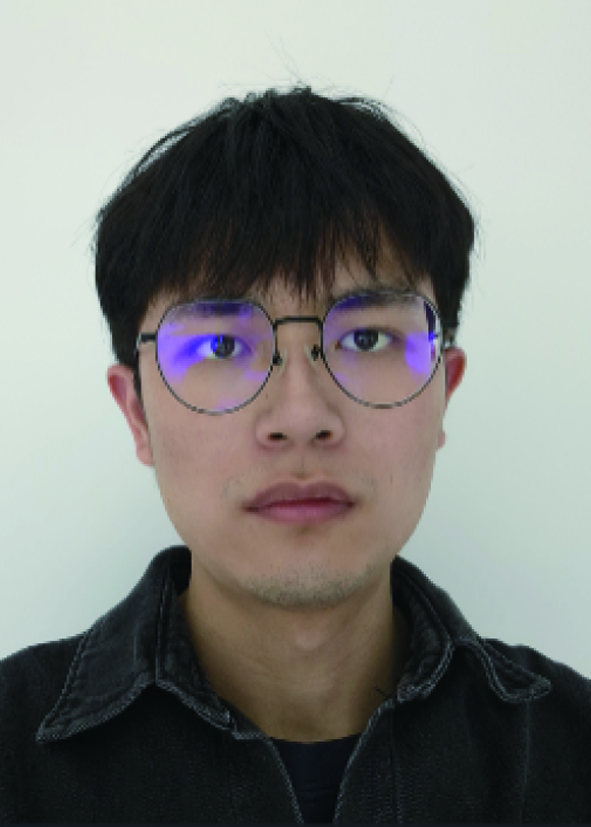 Huifan Xiong is currently working toward the PhD degree at the School of Materials Science and Engineering, Zhejiang University. His current research interests mainly include irradiation and detectors of SiC.
Huifan Xiong is currently working toward the PhD degree at the School of Materials Science and Engineering, Zhejiang University. His current research interests mainly include irradiation and detectors of SiC. Lihui Song received his PhD degree at the University of New South Wales in 2015. He then worked in Hangzhou Dianzi University as an associate professor. He now works at Zhejiang University Hangzhou Global Scientific and Technological Innovation Center as a researcher. His research focuses on the impurity and defect engineering in semiconductors.
Lihui Song received his PhD degree at the University of New South Wales in 2015. He then worked in Hangzhou Dianzi University as an associate professor. He now works at Zhejiang University Hangzhou Global Scientific and Technological Innovation Center as a researcher. His research focuses on the impurity and defect engineering in semiconductors. Deren Yang is an academician of the Chinese Academy of Science, president of NingboTech University, director of the Faculty of Engineering at Zhejiang University and chief scientist of Zhejiang University Hangzhou Global Scientific and Technological Innovation Center. He received his PhD in 1991, at Zhejiang University. In the 1990s, he worked in Japan, Germany, and Sweden for several years as a visiting researcher. He has been engaged in research on silicon materials for microelectronic devices, solar cells, and nanodevices.
Deren Yang is an academician of the Chinese Academy of Science, president of NingboTech University, director of the Faculty of Engineering at Zhejiang University and chief scientist of Zhejiang University Hangzhou Global Scientific and Technological Innovation Center. He received his PhD in 1991, at Zhejiang University. In the 1990s, he worked in Japan, Germany, and Sweden for several years as a visiting researcher. He has been engaged in research on silicon materials for microelectronic devices, solar cells, and nanodevices. Xiaodong Pi received his PhD degree at the University of Bath in 2004. He then carried out research at McMaster University and the University of Minnesota at Twin Cities. He joined Zhejiang University as an associate professor in 2008. He is now a professor in the State Key Laboratory of Silicon and Advanced Semiconductor Materials, the School of Materials Science and Engineering and Zhejiang University-Hangzhou Global Scientific and Technological Innovation Center. His research mainly concerns group Ⅳ semiconductor materials and devices.
Xiaodong Pi received his PhD degree at the University of Bath in 2004. He then carried out research at McMaster University and the University of Minnesota at Twin Cities. He joined Zhejiang University as an associate professor in 2008. He is now a professor in the State Key Laboratory of Silicon and Advanced Semiconductor Materials, the School of Materials Science and Engineering and Zhejiang University-Hangzhou Global Scientific and Technological Innovation Center. His research mainly concerns group Ⅳ semiconductor materials and devices.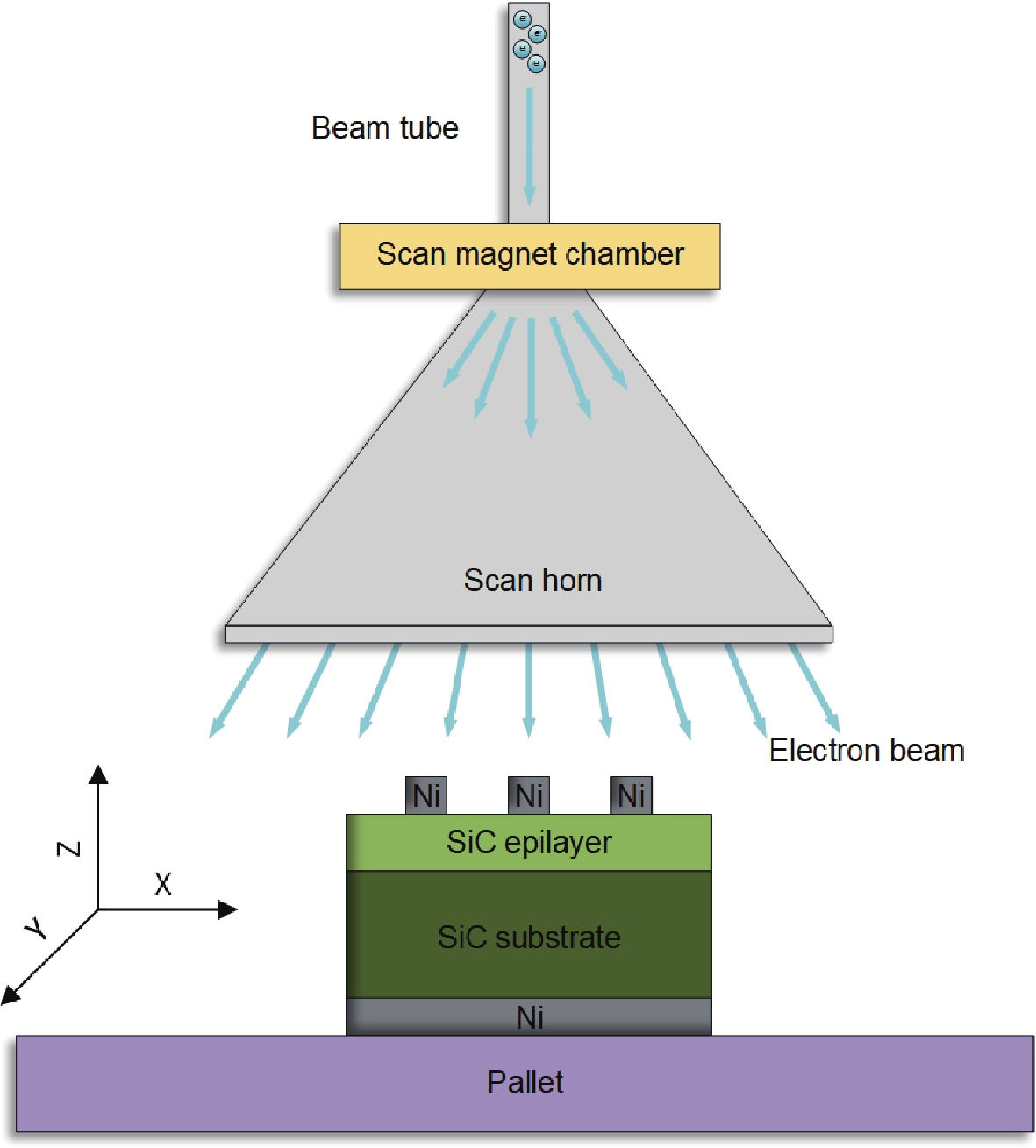
 DownLoad:
DownLoad:
